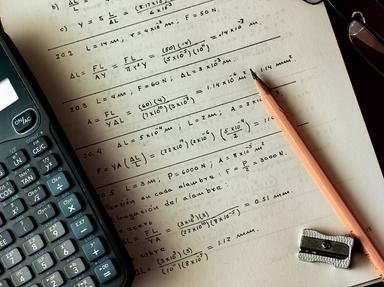Quiz Answer Key and Fun Facts
1. Consider the function f(x)=ax^3+bx^2+cx+d, where a, b, c, and d are constants and a>0. Let f1(0), f2(0), and f3(0) denote the first, second, and third derivatives of f at x=0, respectively. The signs of f1(0), f2(0), and f3(0) (again, respectively) could NOT be which of the following?
2. Consider the function f(x)=sin(x)/e^(x), and let P be the point where the minimum value of f(x) occurs. Which of these is true at P?
3. One of Zeno's paradoxes states that one can never arrive somewhere. This is because one must first travel halfway there, then half the remaining distance, and then half of that distance, etc. If I want to run 10km, I would thus start by running a half-distance of 5 km, then a half-distance of 2.5 km, then 1.25 km, etc. In my case, what is the sum as the number of half-distances traveled approaches infinity?
4. Consider the following three sequences, assuming that a>0 and r>0:
I.Sn=cos(n*pi)*(-1)^n
II.Sn=a(r)^n
III.Sn=1/[ln(5^n)+1,000]
Which statement is true?
5. The circulation time of a mammal is proportional to the fourth root of the mammal's body mass. If the circulation time is in seconds and the body mass is in kilograms, the proportionality constant is 17.40. A boy is growing, and his body mass is 55 kg and is increasing at a rate of 0.2kg/month. What is the rate of change of the boy's circulation time?
6. A continuous, non-constant function f is defined on the closed interval [a,b]. Which of the following statements is true?
7. Let f(x) be a differentiable, decreasing function. Which quantity is largest, assuming that f'(5) and f'(0) all have different values, and neither is equal to 0?
8. Consider the curve defined by y^3-xy=-6. At what point is the tangent line to the curve vertical?
9. Let f(x)=(x^2+4x)^(1/3). Let g(x) be an antiderivative of f(x), and let g(5)=7. Find g(1). Hint: a calculator is required for this problem, but you must perform some intuitive calculus before you get to the point where you can use it.
10. I have a string that is 50 feet long. I can make a cut in the string such that I have 2 pieces, and will bend one piece into an equilateral triangle and another into a rectangle whose length is twice the width. My goal is that the total area (triangle+rectangle) be maximized. How many feet of the string should I use for the triangle?
Source: Author
Diceazed
This quiz was reviewed by FunTrivia editor
crisw before going online.
Any errors found in FunTrivia content are routinely corrected through our feedback system.
